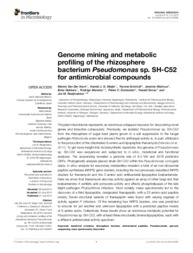Genome mining and metabolic profiling of the rhizosphere bacterium Pseudomonas sp. SH-C52 for antimicrobial compounds.
Genome mining and metabolic profiling of the rhizosphere bacterium Pseudomonas sp. SH-C52 for antimicrobial compounds.
Autoria: VOORT, M. van der; MEIJER, H. J. G.; SCHMIDT, Y.; WATROUS, J; DEKKERS, E.; MENDES, R.; DORRESTEIN, P. C; GROSS, H.; RAAIJMAKERS, J. M.
Resumo: Abstract: The plant microbiome represents an enormous untapped resource for discovering novel genes and bioactive compounds. Previously, we isolated Pseudomonas sp. SH-C52 from the rhizosphere of sugar beet plants grown in a soil suppressive to the fungal pathogen Rhizoctonia solani and showed that its antifungal activity is, in part, attributed to the production of the chlorinated 9-amino-acid lipopeptide thanamycin (Mendes et al., 2011). To get more insight into its biosynthetic repertoire, the genome of Pseudomonas sp. SH-C52 was sequenced and subjected to in silico, mutational and functional analyses. The sequencing revealed a genome size of 6.3 Mb and 5579 predicted ORFs. Phylogenetic analysis placed strain SH-C52 within the Pseudomonas corrugata clade. In silico analysis for secondary metabolites revealed a total of six non-ribosomal peptide synthetase (NRPS) gene clusters, including the two previously described NRPS clusters for thanamycin and the 2-amino acid antibacterial lipopeptide brabantamide. Here we show that thanamycin also has activity and affects phospholipases of the late blight pathogen Phytophthora infestans. Most notably, mass spectrometry led to the discovery of a third lipopeptide, designated thanapeptin were found with varying degrees of activity against P. infestans. Of the remaining four NRPS clusters, one was predicted to encode for yet another and unknown lipopeptide with a predicted peptide moiety of 8-amino acids. Collectively, these results show an enormous metabolic potential for Pseudomonas sp. SH-C52, with at least three structurally diverse lipopeptides, each with a different antimicrobial activity spectrum.
Ano de publicação: 2015
Tipo de publicação: Artigo de periódico
Unidade: Embrapa Meio Ambiente
Observações
1 - Por padrão são exibidas publicações dos últimos 20 anos. Para encontrar publicações mais antigas, configure o filtro ano de publicação, colocando o ano a partir do qual você deseja encontrar publicações. O filtro está na coluna da esquerda na busca acima.
2 - Para ler algumas publicações da Embrapa (apenas as que estão em formato ePub), é necessário ter, no celular ou computador, um desses softwares gratuitos. Sistemas Android: Google Play Livros; IOS: iBooks; Windows e Linux: software Calibre.
Acesse outras publicações
Acesse a Base de Dados da Pesquisa Agropecuária (BDPA) para consultar o acervo completo das bibliotecas da Embrapa.

